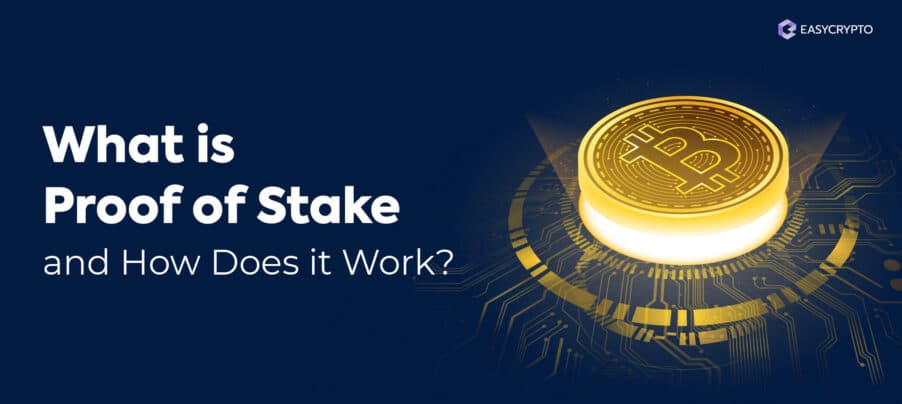What is Proof of Stake (PoS)?
Here is what you need to know about proof-of-stake and why it’s a great protocol for coin holders and long-term crypto investors.


Proof of Stake is an innovative protocol that is commonly applied in the latest crypto blockchains to manage its distributed ledger network. In a sense, it is more inclusive as ordinary persons can participate to verify transactions and earn transaction fees on the side.
While the idea is almost as old as Bitcoin, it is the latest buzzword as Ethereum’s developers are working to get the second-biggest cryptocurrency to transition from Proof of Work to Proof of Stake.
But what does this all mean? Why is the switch to Proof of Stake so important? And how can you become one of the network participants to help verify transactions and receive rewards for it?
Learn more: What is Ethereum (ETH)? A Complete Guide in 2021
What is Proof of Stake ?
The Proof of Stake protocol eliminates the need for crypto mining equipment. Instead, validators stake or deposit their wealth into a special wallet which then freezes the cryptocurrency as collateral.
The validators can simply use their ordinary computers to listen to transactions, propose a block of transactions, and create a new block if chosen to become a block producer.
The system chooses a block producer at random using several factors like the amount of coins held at stake (hence the term Proof of Stake), the coin age, and other pseudo-random multipliers.
In Proof of Stake, ownership of cryptocurrency matters. If a single validator owns more than 50% of the total coins ever created, then that person has the greatest chance of being chosen as a block creator multiple times.
Of course, this is highly unlikely and it is financially impractical for anyone to try to ‘take over’ the blockchain in this way.
What is a consensus protocol?
Proof of Stake is a solution to a problem. In order to fully appreciate what Proof of Stake does, you need to understand the original problem brought by digital currencies, as highlighted by Bitcoin’s creator Satoshi Nakamoto.
Benefits of Proof of Stake
Proof of Stake offers to lower the unnecessary risks posed by the Proof of Work system. It opens up the opportunity for more people to become validators and to keep the network more decentralised.
The biggest capital investment a validator would need to make is a standard-quality computer, a reliable Internet connection, and 90% less electricity than what traditional miners would require. The rest of the investment fund may not be cash-liquid, but at least it takes the form of cryptocurrency that is locked in.

When a validator decides to retire, the stake can be released, and the validator enjoys earnings in capital gain from coin appreciation, on top of the collected transaction fees. In this model, little money, power, or space is lost in the process of generating new cryptocurrencies.
Proof of Stake is truly inclusive in the way that anyone with sufficient wealth and a little bit of technical know-how can become a validator.
Keeping the ‘lottery element’ of Proof of Work
Not requiring crypto mining equipment does not mean just anyone can become a validator, even though a greater proportion of the network nodes can become validators if they choose. In order to become a validator, one must lock in a minimum amount of coins — and this number is not small.
This high overhead cost to become a validator was also put in place to ensure that validators follow the rules that serve the interest of the blockchain.
Should any malevolent actor decide to falsify a transaction and is discovered to do so, the system ‘slashes’ the stake with a hefty fine. This provides an authentic financial incentive to stay on the course.
What is the difference with Proof of Work?
Before Proof of Stake was developed, Proof of Work was thought to be the only way to ensure security in a distributed ledger network.
In Proof of Work, computers that verify transactions (in this context, they are called ‘miners’) race to solve difficult, random and varying computer puzzles (hash guess-and-check).
The one who solves the puzzle the fastest for one instance gets to decide the order of transactions that goes into the official distributed ledger — and everyone else must comply.
It is near impossible to always be the first to solve the cryptographic puzzles, since it requires huge amounts of computational power.
In effect, the Proof of Work protocol introduces randomness and that miners earn new Bitcoins effectively through some kind of lottery.
Why is it called ‘proof’ of work — like, what is there to proof using work? Apart from making it unlikely that the same computers will always have a say in how the ledger is organised, Proof of Work protects the integrity of the ledger.
A malevolent actor can introduce a fraudulent transaction into the ledger — but it takes work, lots of work.
In fact, unless the malevolent actor controls more than 50% of the computers that are in the network, it would take sheer astronomical luck to get every other computer to accept that transaction as legitimate through a small amount of computational work.
In Proof of Work, the network trusts those with the most computational work put into creating and maintaining the blockchain.
Read more: What is Proof of Work and how does it work?
The problem with Proof of Work
Proof of Work may be an ingenious advancement of digital security, but it is not perfect. With great computational power comes great electric bills, and the Bitcoin network alone consumes nearly the same amount of energy as Switzerland at 58.93 terawatt-hours per year as of 2019.
Although you can argue that the traditional financial systems use more energy, this isn’t a contest of who uses the least amount of energy, but rather who uses energy most efficiently.

The revenue generated by Bitcoin miners when they sell their rewarded Bitcoins for fat currency is used to pay for their services, machines, and electricity. Specifically, around 90% of the revenue is used to pay the electricity bills. This is no doubt an inefficient use of resources that can negatively impact the environment.
Why Proof of Work is economically inefficient
Coin miners usually have to take some real capital risk of investing in ASIC machines, reliable and fast Internet, and consistent high-voltage power supply to run the power-hungry mining rig.
The high price of coins is a reflection of the cost of producing crypto coins. Earning the block reward is just one step of a series of steps to make the mining rig profitable. A miner must sell part of the earnings to pay the bills and realise the monetary profits earned from mining, should they choose to do so.
Crypto mining rigs are not legal in some countries, and in those countries, those who risk a crackdown must conceal any evidence of their existence — which is nearly impossible.
Expensive ASIC machines also need to be sold for additional earnings, if a miner decides to retire. As you know, selling something that depreciates in value, in exchange for currencies that also depreciate in value is… unwise at best.
Not many operations are successful because mining pools that combine the resources of thousands of participants usually beat the smaller and private mining computers in the global computational work contest.
How to stake your cryptocurrencies
Proof of Stake cryptocurrencies are becoming popular in part due to its security, processing speeds, as well as inclusivity. Many coin holders (or should I say, Hodlers) are interested in staking their cryptos so that they can both passively and actively invest in cryptos.
I’ll write a full, comprehensive guide to staking in the future. For now, I’ll give you the gist of it.
There are four main ways to earn passive income through staking:
- Setting up a validator node
- Joining a staking pool
- Subscribing to a staking service
- Use a staking wallet
- Delegating a validator node (if possible)
In general, it takes some technical knowledge to properly set up a validator node and become a validator. So, a Word of Caution: Improper set up of validator nodes may risk your stake to become slashed if the system falsely deems it as code manipulation or tampering.
Joining a staking pool is the most popular route as you deposit your coins with other people to be able to meet the minimum requirement for staking.
You and possibly dozens of others will be assigned to a validator that you don’t have to control; the transaction reward will be divided in proportion to however much you invested.
Some people opt to lend their investment money to services that know how to set up a validator node properly. This is different from a staking pool in that you get to reap 100% of the transaction rewards if your delegated validator node is chosen.
In a similar vein to a staking service, a staking wallet is usually coupled with other DeFi services to make the most of your investment.
For example, while staking, you can also borrow or lend crypto tokens that are backed by the staked coins. You may even earn more in interest for using a staking wallet than if you stake using the traditional methods mentioned above.
The future for Proof of Stake
As Ethereum 2.0 nears its completion, and many altcoins mature, many passive income opportunities will show themselves for those who simply want to hold onto coins.
Cryptocurrencies don’t have to be speculative assets forever. As more people join the crypto revolution, cryptocurrencies become more feasible as long-term stores of value.
The best time to invest in crypto was last year when its value was about to hike. The second-best time to invest in crypto is today.
Start here: Click here to buy Bitcoin, Ethereum, and other cryptocurrencies at the best rates.
Share to
Stay curious and informed
Your info will be handled according to our Privacy Policy.
Make sure to follow our Facebook, Twitter, Instagram, and YouTube channel to stay up-to-date with Easy Crypto!
Also, don’t forget to subscribe to our monthly newsletter to have the latest crypto insights, news, and updates delivered to our inbox.
Disclaimer: Information is current as at the date of publication. This is general information only and is not intended to be advice. Crypto is volatile, carries risk and the value can go up and down. Past performance is not an indicator of future returns. Please do your own research.
Last updated February 2, 2024





